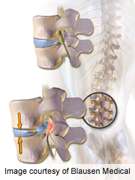Good stability with artificial disc plus cage fusion

(HealthDay) -- For patients with multi-level cervical disc herniation, artificial cervical disc replacement and adjacent segment cage fusion achieves definite stabilization and satisfactory mobility, according to research published online July 24 in the Journal of Spinal Disorders & Techniques.
Xianjun Ren, M.D., of the Xinqiao Hospital in China, and colleagues conducted a prospective, nonrandomized study involving 26 patients (17 male; mean age, 47 years; 12 with myelopathy; 14 with radiculopathy) with multi-level cervical disc herniation who underwent a single-level cervical disc replacement procedure using a Bryan cervical disc prostheses combined with adjacent segment cage fusion.
The researchers found that all patients underwent single-level Bryan disc replacement and cage fusion on adjacent segments, with the segments located next to each other in 23 patients. During 24 to 47 months of follow-up, for all Bryan discs, definite stabilization was achieved. Postoperatively, the average range of motion was 9.5 degrees. In all cages, solid fusion was achieved, with no subsidence or displacement. At the final follow-up, the Japanese Orthopedic Association score increased from 9.2 to 13.5 points and the neck disability index was reduced from 40.8 to 28.5. Based on Odom's criteria, clinical success was 84.6 percent.
"Our early clinical outcome showed that disc replacement combined with cage fusion could produce good stability. It could restore the motion of the cervical spine to a large degree, avoid possible complication of multi-level disc replacement, and reduce the medical cost," the authors write. "However, many issues remain for further study, such as longer-term follow-up, fusion rate of cage, a change of biomechanics of cervical spine, as well as acceleration in device-related wear."
More information:
Abstract
Full Text (subscription or payment may be required)
Copyright © 2012 HealthDay. All rights reserved.















